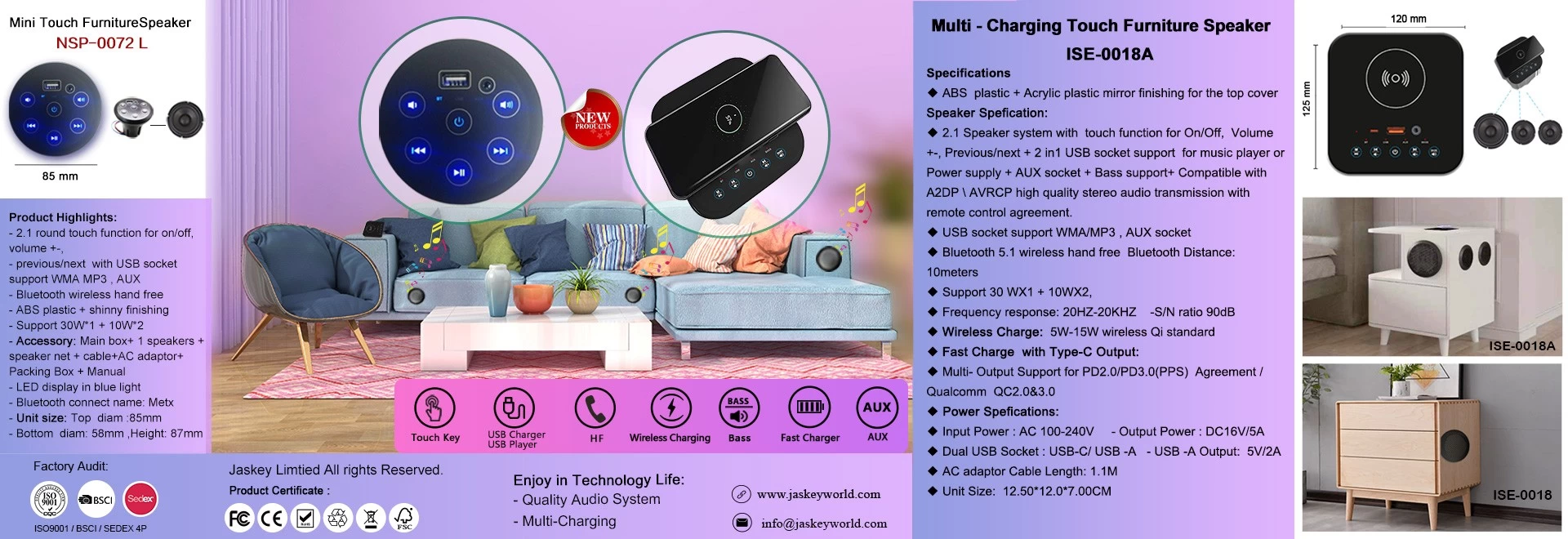How does the portable wireless speakers sound come out?
The portable wireless speakers sound signal converts the wave form of the musical sound wave into the wave form of the electrical signal, so as long as the wave form of the signal also pushes the air, the sound of music can be produced. In the audio system, the equipment that converts electrical signals into sound is the "speaker", which is commonly known as the "speaker". At present, human technology needs to convert electrical energy into sound waves. The most mainstream technology is the "electromagnetic" method. At present, the portable wireless speakers on the market are mainly designed and manufactured using electromagnetic principles. The complete portable wireless speakers will include several parts: speaker unit, crossover network, and portable wireless speakers. We will discuss them in different categories.
Of course, to build a loudspeaker system that can emit high volume and high bandwidth, you need to configure different sound ranges to monomers with different characteristics, such as low frequency range (below 300Hz) for woofer and mid frequency range (300Hz-2500Hz) for midrange Monomer, high-frequency domain (above 2500Hz) separately pronounces the high-pitched monomers and integrates them into a complete sound range. The low frequency needs to push a lot of air, so it needs the largest diaphragm/cone; the mid-range requires less air, so the cone diameter and unit size are smaller and lighter; and the high-range only needs to push the least. Air, so the tweeter is also the lightest diaphragm and the smallest body.
Basically, the larger the diameter of the single cone/diaphragm, the heavier the mass can push more air, but it also has greater inertia so the reaction speed will be reduced, so it is suitable for lower frequencies; on the contrary, the single, the smaller the diameter of the diaphragm, the lighter the mass, the faster the response speed and the higher the frequency, but the relatively limited amount of air that can be pushed. This is why the portable wireless speakers with a little volume on the market will be equipped with multi-channels and multiple monomers for integrated pronunciation.

Of course, if this is the case, the electrical signal of the amplifier must be separated into the high and low frequencies or even the midrange, which is the so-called "frequency division." Generally speaking, there are two ways to divide the frequency of the loudspeaker system. The most mainstream way is to use a passive frequency division network to separate the signal of the amplifier out of sound paths with different frequency ranges. The passive crossover network is simply a "filter" composed of passive inductors, capacitors, and resistors, which filter out the frequency bands outside the range of the sound path, leaving only the required frequency bands to pass. Therefore, the portable wireless speakers are equipped with several sound paths, and there will be several groups of filter networks to form a crossover network, respectively driving the monomers responsible for different sound ranges.
The first is the single speaker. Basically, the working principle of the microphone is reversed. The electrical signal is input to the coil on the voice coil of the magnetic system. The coil will change magnetically with the signal, and drive the voice coil to change in the magnetic system. Wave motion of sound. The voice coil then pushes the diaphragm or cone of portable wireless speakers unit to push the air to generate sound waves, and the portable wireless speaker sound is thus emitted.
It is not difficult to say, but it is another matter to make electrical signals as low as possible in terms of waveform and response as possible. The audio range from low frequency (20Hz) to high frequency (18kHz) exceeds ten octaves. If a single speaker unit can cover this audio range, the volume will be limited by structure.
Another method is "electronic crossover". The signal is sent to the electronic crossover when the signal is still in the pre-output stage to separate the various ranges of the required frequency band. However, an active electronic crossover circuit is used. , Generally speaking, the crossover effect will be better than the passive crossover network. However, the different sound paths derived from the frequency division require separate amplifiers to drive the individual sound paths, which will greatly increase the cost of the speaker system; usually electronic crossovers are used by relatively large speaker systems ( There are also professional listening portable wireless speakers that will be introduced in another article). Finally, these monomers with different sound paths must of course be installed to become a complete speaker system. However, further consideration is needed. The reciprocating vibration of the monomer pushes the air to produce sound, and the sound before and after is "inverted". If it is not processed further, it will have an effect that cancels each other out in the listening space. Therefore, it is necessary to "box" the "back wave" emitted from the rear of the monomer for further processing. Generally speaking, each monomer will have an independent space to deal with the back wave. If the volume of the middle and high pitch is small, a sealed back cavity will be built before the monomer leaves the factory.

Therefore, the portable wireless speaker cabinet is mainly designed for some large-caliber midrange and bass monomers. At present, there are two mainstream ways of speaker cabinet design: closed and open. The mainstream of open is bass reflex, which means that the volume of the bass chamber of the portable wireless speakers and the diameter and length of the reflection duct are calculated, and the low frequency characteristics of the monomer Tune to produce a larger amount of low frequency performance. However, the volume of the closed speaker still has to be calculated by considering the characteristics of the individual, so that the low frequency can be extended to the lowest frequency.










